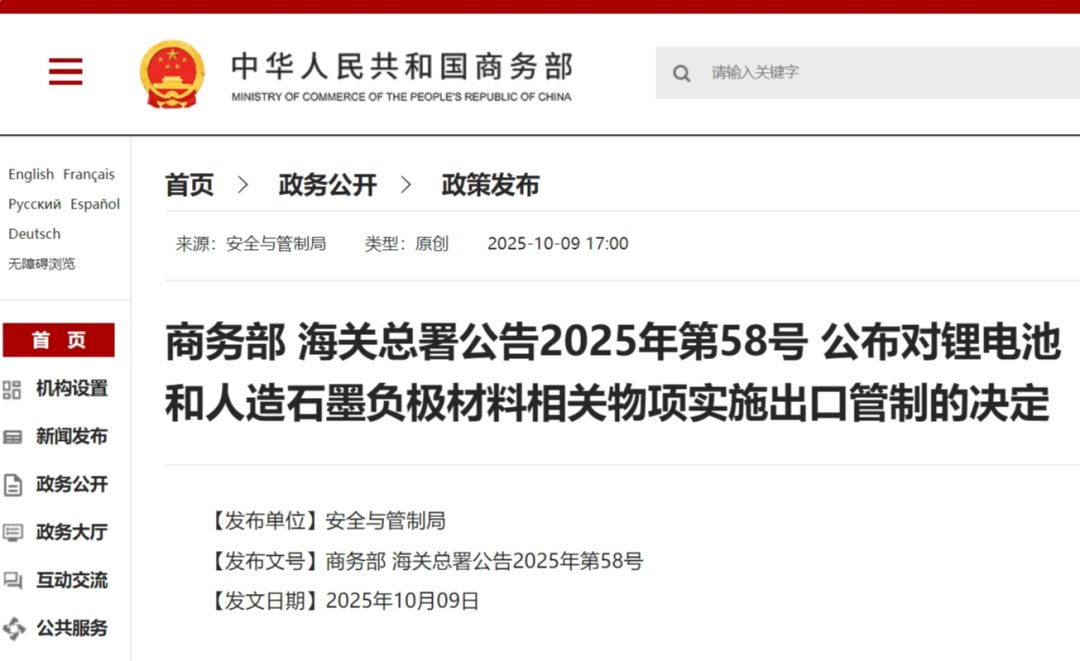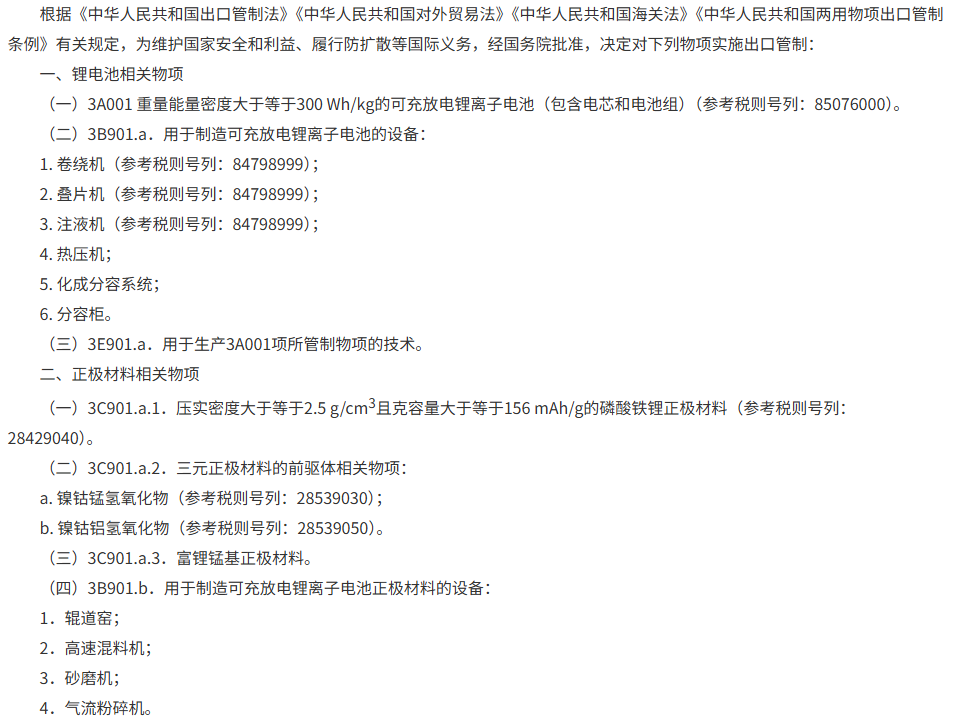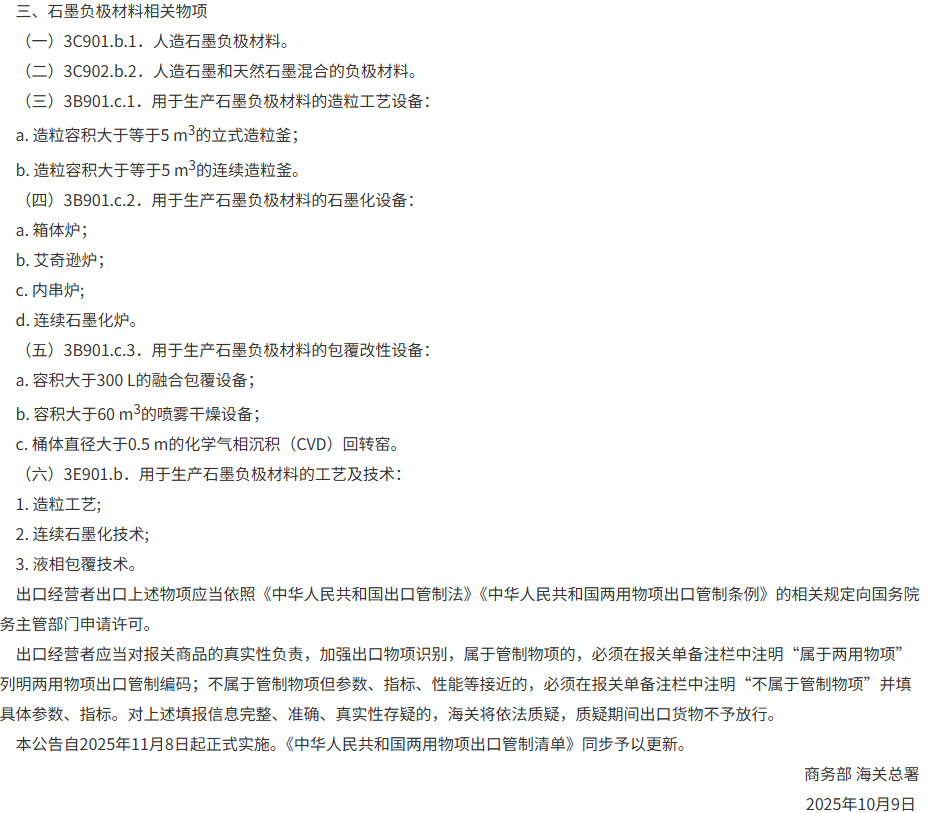Two Departments Issue Notice, Lithium Batteries Subject to Export Controls
On October 9, the Ministry of Commerce and the General Administration of Customs of China jointly issued an announcement. According to the relevant provisions of the "Export Control Law of the People's Republic of China," the "Foreign Trade Law of the People's Republic of China," the "Customs Law of the People's Republic of China," and the "Regulations on the Export Control of Dual-Use Items of the People's Republic of China," it was announced that, effective from November 8, 2025, export controls will be implemented on certain lithium batteries, key anode and cathode materials, and their manufacturing equipment and technology, in order to safeguard national security and fulfill international obligations such as non-proliferation.

Specific controls include:
High-performance rechargeable lithium-ion battery cells and battery packs with an energy density greater than or equal to 300Wh/kg are included in the regulatory scope; related manufacturing equipment, including winding machines, stacking machines, electrolyte filling machines, and formation and grading systems, are also restricted. High compaction density and high specific capacity lithium iron phosphate cathode materials, ternary material precursors, and lithium-rich manganese-based cathode materials are listed, and key equipment used in their production, such as roller kilns, high-speed mixers, and sand mills, are similarly regulated. Artificial graphite anode materials and their mixtures with natural graphite are explicitly restricted, and associated processes and equipment for granulation, graphitization, coating, and modification are also covered.


Amidst the booming wave of the global new energy industry, the export of new energy products has become an important force driving economic growth and international cooperation. The export of a new energy vehicle and its supporting lithium batteries involves three stages: production, assembly, and disassembly. As a core product in the new energy field, the efficient and safe transportation of lithium batteries is crucial for companies to participate in international competition. Data shows that in the first half of the year, China exported 127.3 GWh of power batteries and energy storage batteries, with Germany and the United States being the first and second largest export markets, respectively.
Currently, the energy density of mainstream ternary lithium batteries used in electric vehicles is mostly between 250 and 290 Wh/kg, while lithium iron phosphate batteries are generally below 200 Wh/kg. Therefore, the vast majority of existing battery products are not directly affected, mainly impacting the global high-end battery supply chain, which is the core technological goal for the next generation of electric vehicles. International car manufacturers such as Tesla and Volkswagen are actively laying out plans in this field.
The spokesperson for the Ministry of Commerce stated that the items subject to control this time have obvious dual-use attributes. China's actions are in accordance with laws and regulations to implement export control measures, which align with international practices and are not aimed at any specific country or region. High-end lithium battery technology itself has dual-use characteristics; high energy density batteries can be used not only in electric vehicles but also in military fields such as drones, individual equipment, and underwater vehicles.
【Copyright and Disclaimer】The above information is collected and organized by PlastMatch. The copyright belongs to the original author. This article is reprinted for the purpose of providing more information, and it does not imply that PlastMatch endorses the views expressed in the article or guarantees its accuracy. If there are any errors in the source attribution or if your legitimate rights have been infringed, please contact us, and we will promptly correct or remove the content. If other media, websites, or individuals use the aforementioned content, they must clearly indicate the original source and origin of the work and assume legal responsibility on their own.
Most Popular
-

BASF Signs Another Giant: Covestro Already Set Up, Just Missing Wanhua Chemical?
-

Clariant Unveils Cost-Cutting Plan Details, Plans to Shut Down Multiple Plants
-

Clariant Plans to Shut Down Multiple Plants! Wingtech Releases Latest Statement! Oriental Yuhong Acquires Stake in Brazilian Company
-

U.S. Appeals Court Officially Rules: Trump Tariff Unlawful and Void!
-

ExxonMobil Plans to Close UK Ethylene Plant; GPI's Revenue & Profit Both Decline! Haitian's Serbia Base Enters Mass Production






